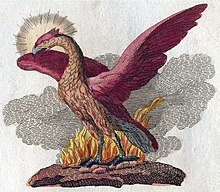Phoenix (mythology)
From Wikipedia, the free encyclopedia
In his study of the phoenix, R. van der Broek summarizes, that, in the historical record, the phoenix "could symbolize renewal in general as well as the sun, Time, the Empire, metempsychosis, consecration, resurrection, life in the heavenly Paradise, Christ, Mary, virginity, the exceptional man, and certain aspects of Christian life".[1]
Contents |
Etymology
The modern English noun phoenix derives from Middle English fenix (before 1150), itself from Old English fēnix (around 750). Old English fēnix was borrowed from Medieval Latin phenix and, later, from Latin phoenīx, deriving from Greek φοίνιξ phóinīx.[2]During the Classic period, the name of the bird, φοίνιξ, was variously associated with the color purple, 'Phoenician', and the date palm.[3] According to an etymology offered by the 6th and 7th century archbishop Isidore of Seville, the name of the phoenix derived from its purple-red hue, an explanation that has been influential. This association continued into the medieval period, albeit in a different fashion; the bird was considered "the royal bird" and therefore also referred to as "the purple one".[3]
With the deciphering of the Linear B script in the 20th century, however, the ancestor of Greek φοίνιξ was confirmed in Mycenaean Greek po-ni-ke, itself open to a variety of interpretations.[4]

Tidak ada komentar:
Posting Komentar